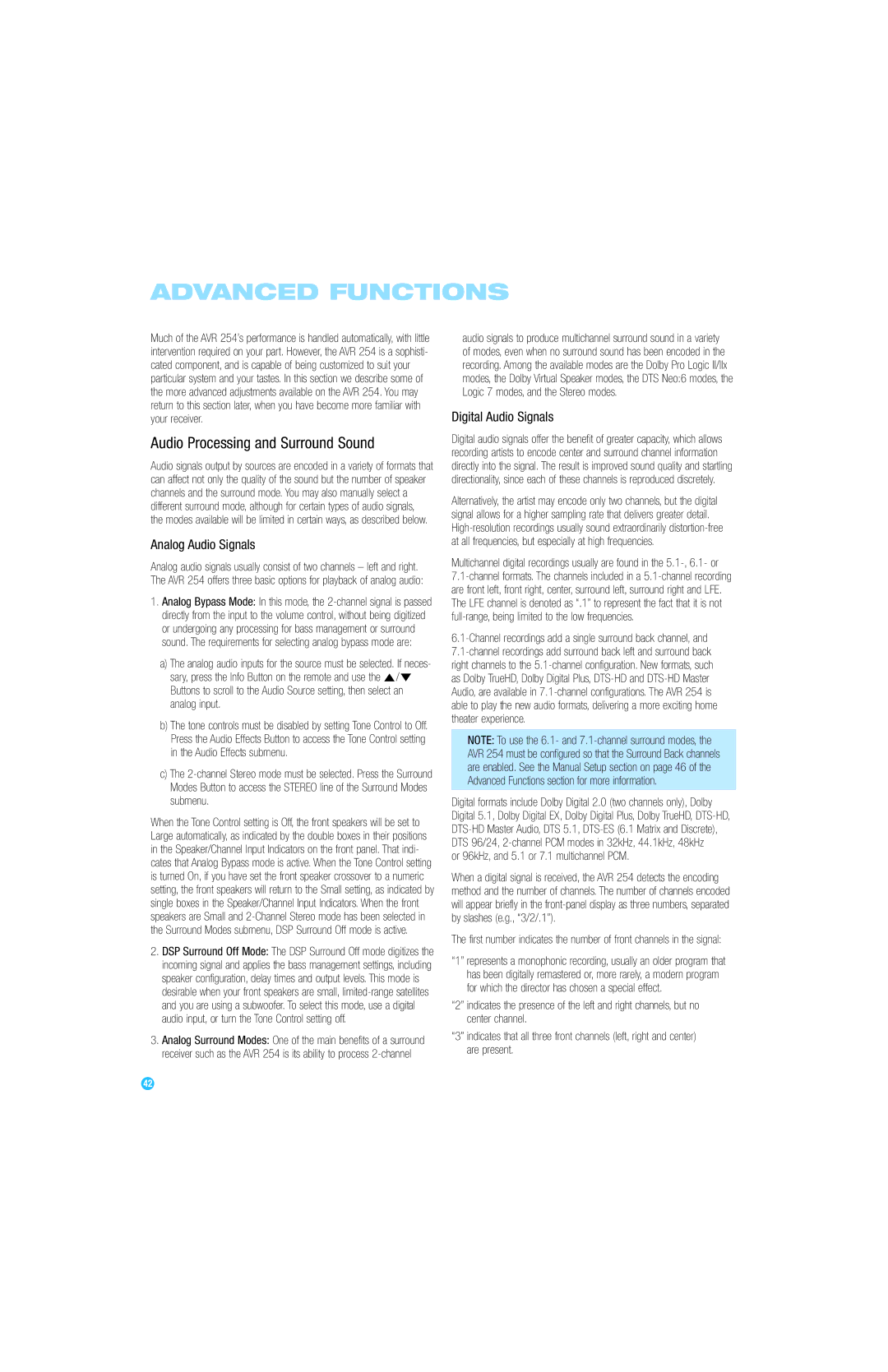
ADVANCED FUNCTIONS
Much of the AVR 254’s performance is handled automatically, with little intervention required on your part. However, the AVR 254 is a sophisti- cated component, and is capable of being customized to suit your particular system and your tastes. In this section we describe some of the more advanced adjustments available on the AVR 254. You may return to this section later, when you have become more familiar with your receiver.
Audio Processing and Surround Sound
Audio signals output by sources are encoded in a variety of formats that can affect not only the quality of the sound but the number of speaker channels and the surround mode. You may also manually select a different surround mode, although for certain types of audio signals, the modes available will be limited in certain ways, as described below.
Analog Audio Signals
Analog audio signals usually consist of two channels – left and right. The AVR 254 offers three basic options for playback of analog audio:
1.Analog Bypass Mode: In this mode, the
a)The analog audio inputs for the source must be selected. If neces- sary, press the Info Button on the remote and use the ⁄ /¤ Buttons to scroll to the Audio Source setting, then select an analog input.
b)The tone controls must be disabled by setting Tone Control to Off. Press the Audio Effects Button to access the Tone Control setting in the Audio Effects submenu.
c)The
When the Tone Control setting is Off, the front speakers will be set to Large automatically, as indicated by the double boxes in their positions in the Speaker/Channel Input Indicators on the front panel. That indi- cates that Analog Bypass mode is active. When the Tone Control setting is turned On, if you have set the front speaker crossover to a numeric setting, the front speakers will return to the Small setting, as indicated by single boxes in the Speaker/Channel Input Indicators. When the front speakers are Small and
2.DSP Surround Off Mode: The DSP Surround Off mode digitizes the incoming signal and applies the bass management settings, including speaker configuration, delay times and output levels. This mode is desirable when your front speakers are small,
3.Analog Surround Modes: One of the main benefits of a surround receiver such as the AVR 254 is its ability to process
audio signals to produce multichannel surround sound in a variety of modes, even when no surround sound has been encoded in the recording. Among the available modes are the Dolby Pro Logic II/IIx modes, the Dolby Virtual Speaker modes, the DTS Neo:6 modes, the Logic 7 modes, and the Stereo modes.
Digital Audio Signals
Digital audio signals offer the benefit of greater capacity, which allows recording artists to encode center and surround channel information directly into the signal. The result is improved sound quality and startling directionality, since each of these channels is reproduced discretely.
Alternatively, the artist may encode only two channels, but the digital signal allows for a higher sampling rate that delivers greater detail.
Multichannel digital recordings usually are found in the
NOTE: To use the 6.1- and
Digital formats include Dolby Digital 2.0 (two channels only), Dolby Digital 5.1, Dolby Digital EX, Dolby Digital Plus, Dolby TrueHD,
or 96kHz, and 5.1 or 7.1 multichannel PCM.
When a digital signal is received, the AVR 254 detects the encoding method and the number of channels. The number of channels encoded will appear briefly in the
The first number indicates the number of front channels in the signal:
“1” represents a monophonic recording, usually an older program that has been digitally remastered or, more rarely, a modern program for which the director has chosen a special effect.
“2” indicates the presence of the left and right channels, but no center channel.
“3” indicates that all three front channels (left, right and center) are present.
42
